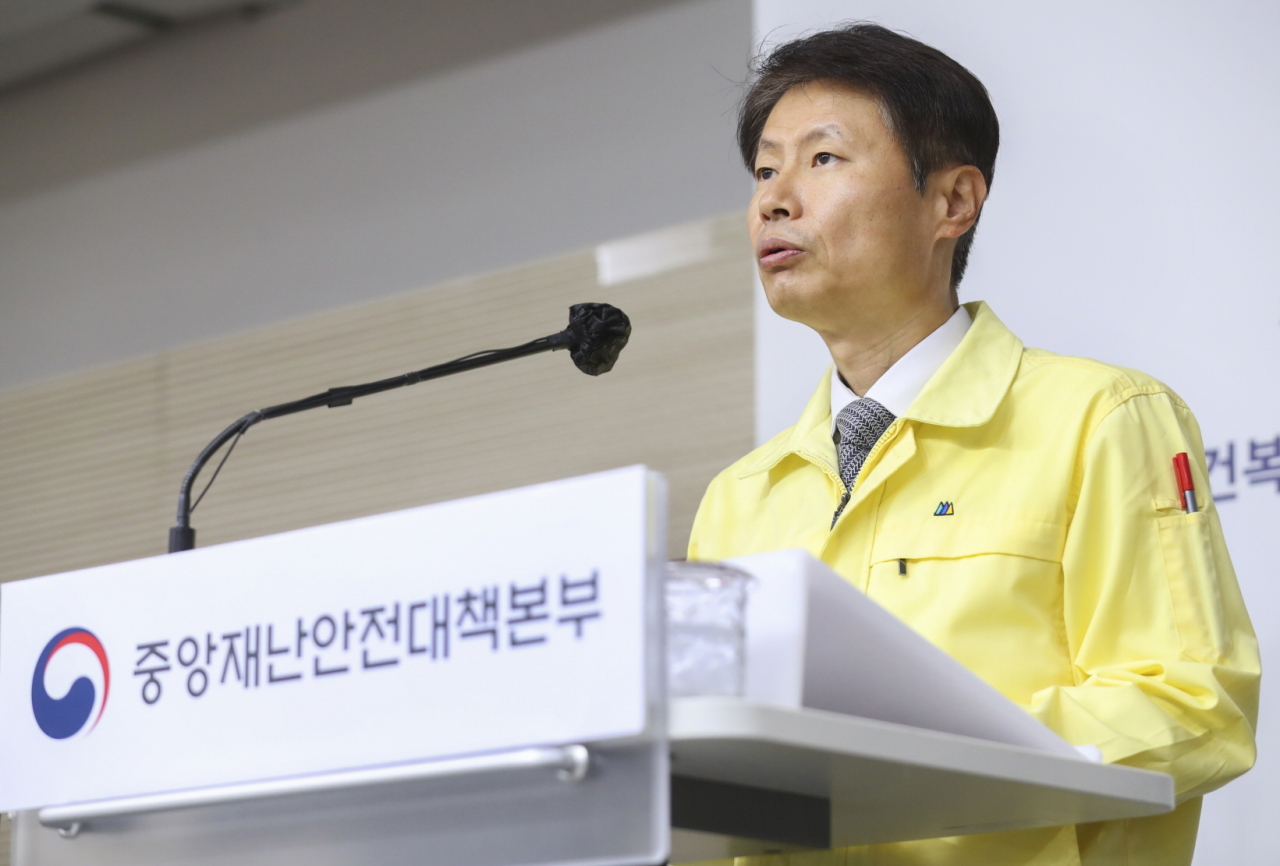 |
|
Vice Health Minister Kim Gang-lip speaks during a news conference on Wednesday. (Ministry of Health and Welfare)
|
Korea’s physical distancing blueprint may be getting an upgrade ahead of Chuseok to allow the country to respond to evolving outbreaks more flexibly, the Ministry of Health and Welfare said Wednesday.
Vice Minister of Health and Welfare Kim Gang-lip said in a news briefing the three-tiered physical distancing framework may be updated in order to make the shifts between tiers more gradual. The ministry set out the tiered system in June for determining the intensity and timing of social distancing restrictions based on key metrics such as case growth.
“The details of the physical distancing plan will be complemented and revised to better reflect the practical effect of the rules,” he said. “Another consideration is by how much of the economy can we allow to open up so that the medical systems won’t be overburdened.”
Seoul and adjacent cities were bumped down a tier Sunday after trying out a compromised version of the most stringent tier for two weeks. While moving into the middle tier necessitates a daily case count of below 100, the government made an exception for economic reasons.
Dining is permitted at all food outlets, and some higher-risk places such as gyms can open under the softened tier, although the minutiae of the guidance differ per city. Daegu, for instance, is implementing a 4-square-meter rule for each person in indoor settings.
Korea confirmed 113 more novel coronavirus cases 105 locally transmitted and eight imported on Wednesday, bringing the cumulative number of cases to 22,504, according to the Korea Disease Control and Prevention Agency.
Cases tied to international travel make up around 9 percent of cases reported from Sept. 2-15. While some have called for travel controls to be lifted, Kwon Jun-wook, deputy chief of the national disease control agency, said in a briefing that “risks of imported infections remain just as high today, if not higher.”
A “constant monitoring of overseas trends” was imperative as the pandemic worsens, he said. Global cases neared 30 million as of Tuesday, according to the World Health Organization report.
Since introducing a compulsory 14-day quarantine for all those arriving in the country in April, Korea has adopted a risk-based approach, either easing or tightening regulations based on perceived risks of the country of departure.
Recent changes in border measures involve resumption of flights to and from the pandemic’s former epicenter Wuhan, a central Chinese city, starting Wednesday. “The coronavirus situation in China has stabilized considerably,” said Kim, the vice minister, in explaining the decision.
Kim added that Korea will not reciprocate China’s travel requirements for Korean passengers, which include a proof of a negative RT-PCR test. Korea only requires the test results for passengers from countries deemed to have a high COVID-19 risk. China is not one of them.
Meanwhile, Korea’s local cases bounced back to triple-digit figures after falling below 100 for the last three days. Most of the new local cases were registered in the Seoul metropolitan area that includes Incheon and Gyeonggi Province, recording 86.
The populous Seoul area now has more cases than any other region in the country, logging 8,476 cases in total. This exceeds the combined tally of Daegu and North Gyeongsang Province, which suffered the most acute outbreak of the coronavirus in February and March.
After the physical distancing restrictions were eased Monday, the Ministry of Education announced that elementary, middle and high school students as well as kindergarteners in the Seoul area will return to classrooms starting next week.
Family gatherings involving children who have been in classrooms are strongly discouraged, said Kim, in response to a press question. “The risk of the children visiting their grandparents or older relatives after in-person classes is very high.”
The five-day Chuseok holiday is anticipated to be a big test for disease control efforts.
The ministry said over the weekend there will be “special measures” in place during the major holiday, without unveiling what they are. The vice minister hinted that the current tier of restrictions may be kept in place, but with extra rules attuned for holiday activities.
Coronavirus deaths have surged by 27 in just the past week. So far, 367 people have died from COVID-19, with the overall death rate standing at 1.63 percent. The rate is higher for elderly patients, killing nearly 1 in 5 of those 80 years or older.
Adults aged 60 or above, who are at increased risk of severe disease, account for 39.3 percent of the 916 patients diagnosed between Sept. 10-16. As the disease affects older people more severely, health experts worry this could lead to a surge in hospitalizations.
Intensive care units at hospitals across the country are already overloaded, with 92 percent of the total 517 beds filled as of Tuesday afternoon. The bed occupancy rate at designated coronavirus hospitals reached 37 percent.
Not all patients with COVID-19 are moved to hospitals, however. Patients with mild to moderate cases are isolated at nonhospital facilities overseen by health officials. This might also have to change, health officials said earlier this month, to boost bed availability. At-home care may become an option for patients who are mildly ill starting next month.
The number of recoveries reached 19,310, up 432 from a day prior. Since late June, the bar for discharging patients has been adjusted to free up bed spaces. Patients who remain without symptoms for 10 consecutive days since diagnosis are considered officially recovered and released from medical care.
By Kim Arin (arin@heraldcorp.com)